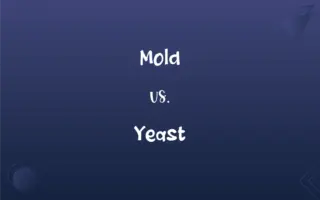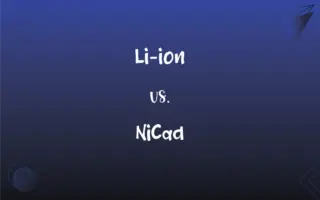High Fructose Corn Syrup vs. Sugar: What's the Difference?
Edited by Aimie Carlson || By Harlon Moss || Published on March 18, 2024
High fructose corn syrup (HFCS) is a sweetener made from corn, richer in fructose than regular sugar, which is sucrose derived from sugar cane or beets.

Key Differences
High fructose corn syrup (HFCS) and sugar are two commonly used sweeteners in the food industry, each with distinct properties and sources. HFCS is derived from corn starch and treated with enzymes to convert glucose into fructose, creating a sweetener that is often considered more versatile in food processing. On the other hand, sugar, typically sourced from sugar cane or sugar beets, is composed of sucrose, a molecule made up of glucose and fructose in equal parts.
The production processes of HFCS and sugar differ significantly. HFCS is created through a more industrialized process involving the enzymatic treatment of corn starch to produce a high fructose content. Sugar's production is more straightforward, involving the extraction and crystallization of sucrose from sugar cane or beet plants. This fundamental difference affects their applications in food manufacturing and consumer preferences.
Nutritionally, both HFCS and sugar contribute calories and sweetness to foods and beverages, but their health implications have been debated. Some studies suggest that the body metabolizes HFCS differently than sugar, potentially influencing obesity and diabetes rates, although consensus is not absolute. The debate centers around HFCS's higher fructose content, which metabolizes in the liver, versus sucrose, which is metabolized more broadly.
In terms of usage, HFCS is a preferred sweetener in many processed foods and soft drinks due to its cost-effectiveness and liquid form, which offers certain advantages in manufacturing. Sugar, however, is often preferred for its natural image and taste, especially in products marketed as organic or natural. Consumers might choose products sweetened with sugar over HFCS based on health perceptions or taste preferences.
Despite their differences, both HFCS and sugar have faced criticism for their role in the global increase in dietary sugar intake and related health issues. The choice between using HFCS and sugar can reflect factors ranging from cost and manufacturing requirements to marketing strategies and consumer health perceptions. As awareness of sugar intake's health impacts grows, both sweeteners are scrutinized for their contributions to diet and disease.
ADVERTISEMENT
Comparison Chart
Source
Derived from corn starch
Extracted from sugar cane or sugar beets
Composition
Higher fructose content, can vary (e.g., HFCS-55, HFCS-42)
Sucrose, a 50-50 fructose-glucose molecule
Production Process
Enzymatic processing of corn starch to increase fructose
Extraction and crystallization of sucrose
Usage in Foods
Preferred in processed foods and soft drinks for solubility
Preferred for taste and natural image
Health Perceptions
Often viewed negatively due to association with health issues
Considered more natural, but concerns remain
ADVERTISEMENT
Cost
Generally cheaper due to corn subsidies and processing
More expensive, depending on market and source
Taste
Sweet, but can affect flavor profiles differently
Characteristic sweet taste
Physical Form
Liquid, facilitating ease of use in manufacturing
Solid (granulated) or liquid (syrup)
High Fructose Corn Syrup and Sugar Definitions
High Fructose Corn Syrup
Cheaper alternative to traditional sweeteners.
Manufacturers prefer high fructose corn syrup for its low cost.
Sugar
Comes in various forms, including granulated, powdered, and brown.
I need brown sugar for this cookie batch.
High Fructose Corn Syrup
A sweetener made by converting glucose from corn starch into fructose.
Soda companies often use high fructose corn syrup for its sweetness.
Sugar
Used as a primary sweetener in baking.
The recipe calls for a cup of sugar.
High Fructose Corn Syrup
Linked to health debates.
Nutritionists question the impact of high fructose corn syrup on obesity.
Sugar
Essential in preserving jams and jellies.
Sugar helps to thicken the jam as it cooks.
High Fructose Corn Syrup
Used extensively in processed foods.
The cake's sweetness comes from high fructose corn syrup.
Sugar
A sweet crystalline substance obtained from sugar cane or beets.
She added sugar to her coffee to taste.
High Fructose Corn Syrup
Can be found in various concentrations.
Beverages might contain high fructose corn syrup-55 for extra sweetness.
Sugar
Can contribute to health issues when consumed in excess.
Doctors advise limiting sugar intake to prevent diabetes.
Sugar
A sweet crystalline or powdered substance, white when pure, consisting of sucrose obtained mainly from sugarcane and sugar beets and used in many foods, drinks, and medicines to improve their taste. Also called table sugar.
FAQs
Can consuming sugar affect health?
Yes, excessive sugar intake is linked to obesity, diabetes, and other health issues.
How is sugar produced?
Sugar is extracted and crystallized from sugar cane or sugar beets.
What is high fructose corn syrup made from?
It's derived from corn starch, processed to increase its fructose content.
Why is HFCS often used in processed foods?
Its liquid form and sweetness make it cost-effective and versatile in food production.
How do health perceptions of HFCS and sugar compare?
HFCS often faces more health scrutiny, though excessive consumption of both is considered unhealthy.
Can HFCS and sugar be used interchangeably in recipes?
They can be substituted, but adjustments may be needed for taste, texture, and moisture content.
What role does sugar play in food preservation?
Sugar helps preserve jams and jellies by inhibiting microbial growth.
What's the cost difference between HFCS and sugar?
HFCS is generally cheaper, influenced by corn subsidies and processing costs.
Is HFCS sweeter than sugar?
HFCS can be sweeter, depending on its fructose content, like HFCS-55 used in soft drinks.
Is there a taste difference between HFCS and sugar?
Some people detect a difference in sweetness and flavor profile.
What are the main differences in production between HFCS and sugar?
HFCS involves enzymatic processing of corn starch, while sugar production is more about extraction and crystallization.
How should consumers approach HFCS and sugar in their diet?
Moderation is key, with an awareness of their presence in processed foods and potential health impacts.
Are there different types of sugar?
Yes, including granulated, powdered, and brown sugar, each with specific uses.
How do consumers perceive HFCS and sugar in terms of naturalness?
Sugar is often perceived as more natural compared to the industrially processed HFCS.
How do HFCS and sugar affect baking?
They can affect texture, color, and moisture, requiring recipe adjustments for optimal results.
What is the fructose content in HFCS compared to sugar?
HFCS may have a higher fructose content, especially in forms like HFCS-55, compared to sugar's equal fructose-glucose ratio.
Are there health benefits to choosing sugar over HFCS?
The main concern is overall sugar consumption, rather than the type of sweetener.
Can HFCS be found in natural foods?
HFCS is primarily used in processed foods, not in foods labeled as natural.
Why might a manufacturer choose HFCS over sugar?
For its lower cost, sweetness, and ease of use in liquid form in processed foods.
What are the environmental impacts of producing HFCS and sugar?
Both have environmental footprints, including water usage and land impacts, but specifics vary by region and production practices.
About Author
Written by
Harlon MossHarlon is a seasoned quality moderator and accomplished content writer for Difference Wiki. An alumnus of the prestigious University of California, he earned his degree in Computer Science. Leveraging his academic background, Harlon brings a meticulous and informed perspective to his work, ensuring content accuracy and excellence.
Edited by
Aimie CarlsonAimie Carlson, holding a master's degree in English literature, is a fervent English language enthusiast. She lends her writing talents to Difference Wiki, a prominent website that specializes in comparisons, offering readers insightful analyses that both captivate and inform.







































































